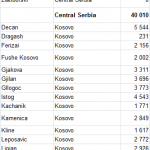http://www.fao.org/nr/water/aquastat/irrigationmap/SRB/index.stm
Serbia
Under the former Federal Republic of Yugoslavia, about 120 000 ha of agricultural land were equipped for irrigation in 288 schemes in Serbia Montenegro [RS01], while in the Kosovo area about 68 000 ha were equipped for irrigation [RS02]. However, at present only about 35 000 ha of schemes are fully operational and 47 000 ha are partially functional. Among other, this is caused by the shortage of markets, redistribution of the Kombinats, adverse farmer financial positions, deterioration in the physical systems, land ownership problems, legal changes and institutional weakness [RS01]. In the Kosovo region the area equipped for irrigation dropped to 23 000 ha in 1999 due to the devastation of war and the lack of maintenance. Thanks to
donor contribution about 51 000 ha were under irrigation again in 2002 [RS03] and the actual extent of the irrigation schemes was given at 77 000 ha [RS02]. The area actually used for irrigation in Serbia Montenegro in the year 2003 was 39 110 ha [RS04] and about 33 000 ha in Kosovo in year 2004 [RS05]. The sub-national irrigation statistics as shown in in the table below, were compiled from two different sources. For Serbia, the area equipped for irrigation by region was assumed to be represented by the maximum of the area intended to be used for irrigation in the period 2001-2005 [RS06]. The total area was summing up to 86 311 ha. For the Kosovo area, the actually irrigated area as derived from the agricultural household survey 2004 by municipality [RS05] was scaled to meet the figures for the total area equipped for irrigation in the entire region (77 000 ha).
Since irrigation maps have not been available, and the Corine 2000 land cover database for Europe also did not cover this region yet, it was decided to distribute irrigated land to areas extracted from the GLC2000 regional product for Europe [RS07] and classified there as „cultivated and managed“.
References
[RS01]: World Bank. 2005. Serbia irrigation and drainage rehabilitation project. Project appraisal document. Report No: 32379-YF, available at: http://www-wds.worldbank. org/, 02/07/2006. [RS02]: World Bank. 2003. Water resources management in South Eastern Europe. Vol. II – Country water notes and water fact sheets. Washington, United States, available at: http://www-wds.worldbank.org/, 07/07/2006. [RS03]: Ministry of Environment and Spatial Planning. 2002. Kosovo state of the environment report. Online report available at: http://enrin.grida.no/ htmls/kosovo/SoE/index.htm, 03/07/2006. [RS04]: Statistical Office of Serbia and Montenegro. 2004. Statistical Yearbook of Serbia and Montenegro 2004. Belgrad, Serbia, 311 pp., available at: http://www.szs.sv.gov.yu/english.htm, 24/05/2005. [RS05]: Statistical Office of Kosovo. 2005. Agricultural household survey 2004. Pristine, Kosovo, 32 pp., available at: http://www.ks-gov.net/esk/, 05/08/2006. [RS06]: The Agriculture Inspection of the Republic of Serbia. unknown. A survey of the arable agriculture land in the Republic of Serbia intended for irrigation (for the period 2001-2005). Table 1.1 in: Ministry for the Protection of the Natural Resources and Environment. 2001. State of the Environment in 2000 and priorities in 2001+ for Serbia. Online publication available at: http://enrin.grida.no/htmls/yugo/serb/index.htm, 05/08/2006. [RS07]: Hartley, A. 2006. The land cover map for Europe for the year 2000. GLC2000 database, European Commision Joint Research Centre, available at http://www-gem.jrc.it/glc2000.Distribution of irrigated area in Serbia (including Kosovo) by Main Region and District:
 Макроекономија Економске анализе, Србија, окружење, и међународна економија
Макроекономија Економске анализе, Србија, окружење, и међународна економија

ovo jednostavno nije tacno i nema veze sa stvarnim stanjem